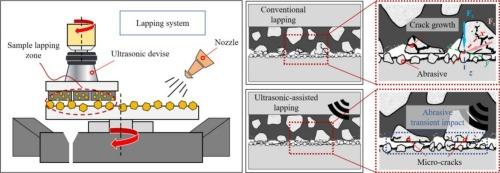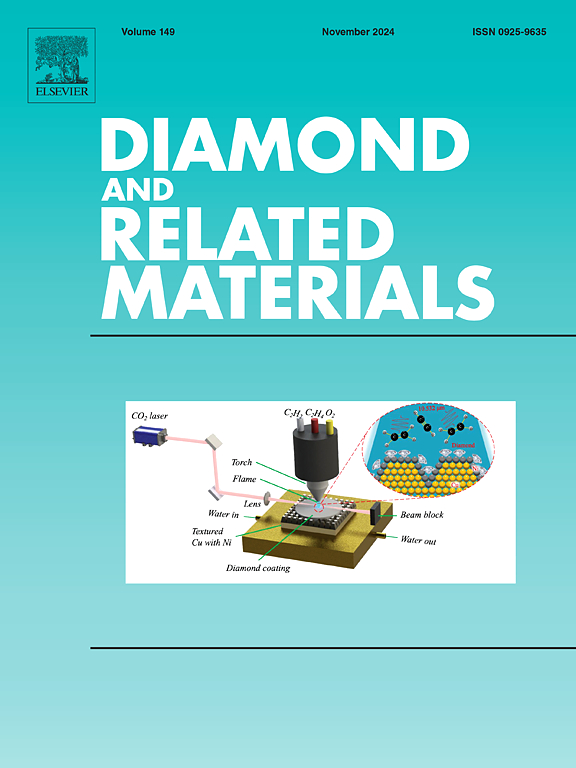Study on ultrasonic-assisted lapping performance and material removal behavior of diamond/SiC composites
IF 4.3
3区 材料科学
Q2 MATERIALS SCIENCE, COATINGS & FILMS
引用次数: 0
Abstract
Diamond/SiC composites have emerged as a new generation of highly promising materials for semiconductor packaging due to their excellent thermal conductivity. However, the exceptionally hard diamond and SiC phases in the composites have made precision machining a substantial difficulty. This study specifically explores the utilization of ultrasonic-assisted lapping (UAL) to enhance the machining performance of diamond/SiC composites. The focus is on investigating the effects of UAL on the material removals, including the brittle-ductile transition of sample interfacial diamond at different ultrasonic conditions, as well as the surface morphology of diamond/SiC composites. The removal mechanism of diamond/SiC composites under different machining conditions and the transient impact action of the abrasive were systematically analyzed, taking into account the abrasive size, the mechanical effects of ultrasonic vibration, and the interplay of processing parameters. The experimental results reveal that UAL significantly changes the traditional removal mode of diamond/SiC composites. At a constant rotational speed, the diamond abrasive size in the lapping solution exerts the primary influence on the sample surface morphology, followed by the average power of ultrasonic. Compared to conventional lapping methods, UAL improves the removal rate by 10.3 %, 5.4 %, and 5.3 % for abrasive sizes of 8 μm, 4 μm, and 1 μm, respectively. Optimally, the best surface quality finish of diamond/SiC composites was achieved with a lapping solution containing 4 μm abrasive particles and an average ultrasonic vibrator power of 75 W. This study underscores the potential of UAL to enhance the efficiency and quality of diamond/SiC composite machining.

金刚石/碳化硅复合材料的超声波辅助研磨性能和材料去除行为研究
金刚石/碳化硅复合材料因其出色的导热性能而成为新一代极具潜力的半导体封装材料。然而,复合材料中硬度极高的金刚石和碳化硅相给精密加工带来了巨大困难。本研究特别探讨了如何利用超声波辅助研磨(UAL)来提高金刚石/碳化硅复合材料的加工性能。重点是研究 UAL 对材料去除的影响,包括不同超声条件下样品界面金刚石的脆-韧性转变,以及金刚石/SiC 复合材料的表面形貌。考虑到磨料尺寸、超声振动的机械效应以及加工参数的相互作用,系统分析了不同加工条件下金刚石/SiC 复合材料的去除机理以及磨料的瞬态冲击作用。实验结果表明,UAL 显著改变了金刚石/碳化硅复合材料的传统去除模式。在恒定转速下,研磨液中的金刚石磨料粒度对样品表面形态的影响最大,其次是超声波的平均功率。与传统研磨方法相比,磨料粒度为 8 μm、4 μm 和 1 μm 时,UAL 的去除率分别提高了 10.3%、5.4% 和 5.3%。这项研究强调了 UAL 在提高金刚石/碳化硅复合材料加工效率和质量方面的潜力。
本文章由计算机程序翻译,如有差异,请以英文原文为准。
求助全文
约1分钟内获得全文
求助全文
来源期刊

Diamond and Related Materials
工程技术-材料科学:综合
CiteScore
6.00
自引率
14.60%
发文量
702
审稿时长
2.1 months
期刊介绍:
DRM is a leading international journal that publishes new fundamental and applied research on all forms of diamond, the integration of diamond with other advanced materials and development of technologies exploiting diamond. The synthesis, characterization and processing of single crystal diamond, polycrystalline films, nanodiamond powders and heterostructures with other advanced materials are encouraged topics for technical and review articles. In addition to diamond, the journal publishes manuscripts on the synthesis, characterization and application of other related materials including diamond-like carbons, carbon nanotubes, graphene, and boron and carbon nitrides. Articles are sought on the chemical functionalization of diamond and related materials as well as their use in electrochemistry, energy storage and conversion, chemical and biological sensing, imaging, thermal management, photonic and quantum applications, electron emission and electronic devices.
The International Conference on Diamond and Carbon Materials has evolved into the largest and most well attended forum in the field of diamond, providing a forum to showcase the latest results in the science and technology of diamond and other carbon materials such as carbon nanotubes, graphene, and diamond-like carbon. Run annually in association with Diamond and Related Materials the conference provides junior and established researchers the opportunity to exchange the latest results ranging from fundamental physical and chemical concepts to applied research focusing on the next generation carbon-based devices.
 求助内容:
求助内容: 应助结果提醒方式:
应助结果提醒方式:


